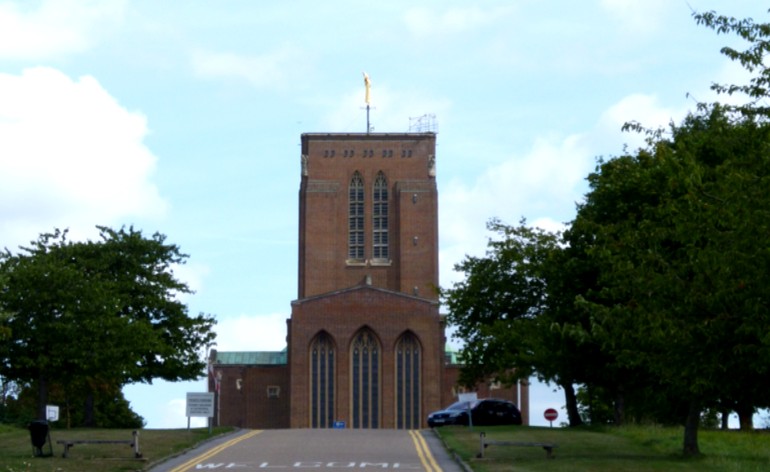Guildford Cathedral or the Cathedral of the Holy Spirit is the Anglican cathedral in Guildford designed by Sir Edward Maufe, an English architect and designer. His skills were perhaps known for designing the Air Forces Memorial, Guildford Cathedral and his work on behalf on the Imperial War Graves Commission which earned him a Knighthood in 1954.
Guildford Cathedral is the mother church of the Diocese of Guildford, covering 500 square miles of Surrey, north east Hampshire, the London Borough of Kingston and a part of West Sussex.
The tower is 160 feet (49 metres) high, and contains twelve bells, ten of which were cast by Mears and Stainbank in 1965. The bells were augmented to 12 with two Whitechapel trebles in 1975.The largest bell weighs 30cwt (just over 1.5 tonnes) and is tuned to the key of D. At the top of the tower stands a 15-foot (4.6 m) gilded angel, which turns in the wind. Inside, the cathedral appears to be filled with light, with pale Somerset limestone pillars and white Italian marble floors.
With a seating capacity of 1000, the Cathedral provides both focus and resource for the whole community, a venue for concerts, art and education, a place of pilgrimage, as well as stillness, prayer and daily choral worship.
During the early part of the twentieth century, the population of south east England grew resulting in a three sector division of The Diocese of Winchester. Initially, the Holy Trinity Church in Guildford was the cathedral but it was not big enough. In 1928 the Diocese resolved to build a new cathedral and so a competition consisting of 183 architects was held and Maufe was appointed as the official architect in 1933.
Work on the cathedral stopped during the Second World War and ten years later little progress was made. The main setback was the lack of money and building materials leaving the cathedral empty. However, from 1947 onwards regular services resumed and services were held in the Crypt Chapel which has now become the choir practice room.
Fundraising began for the construction of the Nave in 1952; the target was £250,000 which was four times the original estimate. A new campaign was introduced called the Buy-a-Brick Campaign. This campaign was a great success, it enabled subscribers to buy a brick for 2s 6d (12½p) and inscribe it with their name. To this day, many people feel that they have a personal link with the Cathedral because of this scheme.
The consecration of the cathedral was in May 1961 despite several setbacks and difficulties. Carried out by Bishop George Reindorp in the presence of Her Majesty the Queen, His Right Honourable the Duke of Edinburgh, the Archbishop of Canterbury and a packed congregation from all parts of the Diocese.
At this stage however, the cathedral was still incomplete and the Western Porches (the Garths), the Sacristy, the Lady Chapel and the Chapter house were yet to be built. The main tower itself was still incomplete and all the projects were not finished until 1966.
Work has continued in subsequent years, but much remains to be done. The latest addition to the Cathedral was in 2005 with the completion of the statues on the West Front. The emphasis now is on the development of the surrounding land.
Visitors are welcomed to visit the cathedral all year round, from any ages. It can also be hired for dinner parties in the Nave, concerts, performances, award ceremonies, festivals and any more.
James Martin



